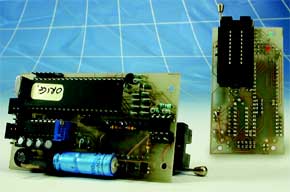PICProg 2003
A versatile PIC production programmer

This is a MEMBER ONLY article. You need a subscription to read this article.
- Access to Elektor archive and 5,000+ Gerber files
- Receive up to 8 magazines per year (digital and/or paper)
- 10% discount in the Elektor store
Available from €4.95 per month.
What is Members Only
Elektor is committed to providing high-quality content on electronics, catering to tens of thousands of paying members. As part of this commitment, Elektor has launched Premium, an initiative that offers exclusive online articles to members sometimes even before they appear in the magazine.
Every day, members can access in-depth articles that showcase the best of Elektor's premium content.
This initiative aims to reward members with early access. Once logged in, members can easily enjoy this exclusive content and engage in discussions about featured projects. While Premium adds to the existing resources available, Elektor will continue to provide a wealth of free information.
Join the Elektor community today to take advantage of Premium and other benefits!
Materials
Gerber file
CAM/CAD data for the PCB referred to in this article is available as a Gerber file. Elektor GREEN and GOLD members can exclusively download these files for free as part of their membership. Gerber files allow a PCB to be produced on an appropriate device available locally, or through an online PCB manufacturing service.
Elektor recommends the Elektor PCB Service service from its business partner Eurocircuits or AISLER as the best services for its own prototypes and volume production.
The use of our Gerber files is provided under a modified Creative Commons license. Creative Commons offers authors, scientists, educators and other creatives the freedom to handle their copyright in a more free way without losing their ownership.
Extra info / Update
Component list
R1-R4,R7-R13,R16-R19 = 10k? SMD
R5 = 220?
R6 = 1k?8
R14,R15 = 1k?
R20,R21,R32 = 47k?
R22,R23,R25,R27,R29,R31 = 30k?0 1%
R24,R26,R28,R30 = 15k?0 1%
R33 = 100k?
P1 = 500? preset, vertical, multiturn
Capacitors:
C1,C2 = 22pF
C3-C6 = 10µF 25V radial
C7-C11 = 100nF SMD
C12 = 470µF 40V axial
Semiconductors:
D1,D2,D3 = 1N4148
D4 = LED, green, 3mm, low-current
D5 = LED, red, 3mm, low-current
T1,T2 = BS250
T3 = BS170
IC1 = 74HC03 SMD
IC2 = 74HC4066 SMD
IC3 = 7805
IC4 = MAX232
IC5 = TL082CP
IC6 = PIC16F874-20/P (programmed, order code 010202-41)
IC7 = LM317LZ
B1 = B80C1500 (round case) (80V piv,
1.5A)
Miscellaneous:
K1 = 40-way ZIF programming socket, plus a 10-way and a 12-way SIL contact strip
K2 = 10-way boxheader
K3 = 9-way sub-D socket (female), with
IDC connector (not on PCB!)
K4 = 6-way SIL pinheader
K5 = 2-way pinheader
K6 = 4-way SIL pinheader
JP1 = 2-way SIL pinheader with jumper
X1 = 18.432MHz quartz crystal
10-way IDC connector
Length of 10-way flatcable
Case, size 120 x 60 x 40 mm, e.g., Velleman # G410
Connector for mains adapter, chassis mount
PCB, order code 010202-1
Disk, Windows software, order code 010202-11 or Free Download
Runtime files, file number 010202-12, Free Download



Discussion (0 comments)